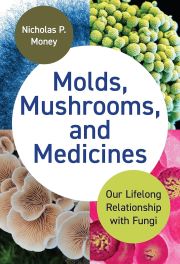Molds, Mushrooms and Medicines: Our Lifelong Relationship with Fungi

Nicholas P. Money
Princeton University Press, £25.00
There is a growing awareness that we are interdependent and intertwined with the whole biosphere, rather than merely being a part of – or worse still, apart from – it. Yet many of us still have a limited appreciation of just how integral our relationships with fungi are, within, upon and around us: from our first gasp until our dying breath. These interactions range from pathogens through a spectrum of symbioses including commensalism and mutualism. Our ‘blindness’ to these organisms is possibly greater than our limited awareness of plants around us, so could be termed Fungal Disparity Awareness Syndrome (FADS).
Money leads us on a tour over the terrain of human skin before going inside the body, where he pauses in the brain, lungs and gut. At each stop he describes a host of fungal partners. The second half of the book outlines some of the instrumental value we place on fungi due to harnessing their fermentation abilities. The list includes several foods and beverages such as alcohol, cheeses, and mycoprotein, as well as numerous medicines. Fungi are famous for having some poisonous species and others that synthesise psychoactive compounds such as psilocybin. Have you ever pondered on the evolutionary advantage of investing in the production of such metabolites? There are some intriguing answers here. The final chapter broadens our thoughts to the mycobiome that extends across the world.
There may be signs that fungi are gaining greater press, but still this vast kingdom gains little serious attention compared to fauna or flora. This text is a welcome addition to tackle FADS, and as such I recommend it.
Dr Alexander Waller FRSB
Reviewed by Dr Alexander Waller FRSB, visiting professor of science education and environmental ethics at the American University of Sovereign Nations


